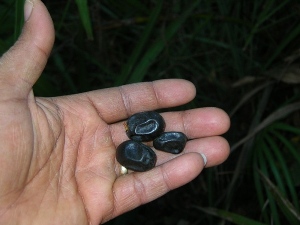
Interactions
What
lives around Serenoa repens?
Plants living around saw palmettos often consist of poorly drained pine flatwoods or well-drained scrubby flatwoods. Sand pines (Pinus clausa) can also be found around them as well.
Their stems are actually found almost entirely underground, but they usually have some of it showing above the surface. They can grow to be 10 to 15 feet long! Serenoa repens is usually a small plant because their stems grow along the top soil, but they can sometimes grow tall and reach 15 to 20 feet in the air. However, this does not occur very often. They grow very slowly at their stems and some are hypothesized to be 500 to 700 years old. This means some are growing from 0.04 in/yr to 0.1 in/yr. You can find their roots located on the ventricle side of the stem. There are usually more of the roots located at the growing end which makes sense because this is where all of the nutrients would primarily need to be to help it grow.
What symbiotic relationships is Saw Palmetto in?
Saw palmetto has many symbiotic relationships with other organisms. They provide other organisms with nests, protective cover and food. One example is the Ammodramus savannarum. The common name is the Florida grasshopper sparrow; which is actually endangered. Saw palmetto is an important factor in helping this sparrow to survive by giving it a place to make nests.
Another interaction is with the Florida panther. This panther uses the plant for natal dens and for a place to take a pit stop and rest. Other symbiotic relationships include ground-nesting rodents, wild turkeys and white-tailed deer. Most of these organisms use the Serenoa repens for nesting, bedding and taking shelter in general.
When Serenoa repens is not being used for shelter or bedding, it can be used as food. Serenoa repens produces fruit that many creatures like to eat. This can be beneficial to the saw palmetto. For example, black bears are said to like saw palmetto's fruit.
 There is a nice picture to the left of the black berries that
black bears love to eat.
So, if the bear eats the fruit, then
consequently the saw
palmetto's seeds will also get eaten. Then when the bear
excretes its waste later it will also excrete the seed. The seed
will then have been transported to a new place, where the new saw
palmetto can grow in a new area. These plants are smart!
However, saw
palmetto's ingenuity is not unique. This is actually a
characteristic of many angiosperms who use many different ways of dispersing their
seeds to different places.
There is a nice picture to the left of the black berries that
black bears love to eat.
So, if the bear eats the fruit, then
consequently the saw
palmetto's seeds will also get eaten. Then when the bear
excretes its waste later it will also excrete the seed. The seed
will then have been transported to a new place, where the new saw
palmetto can grow in a new area. These plants are smart!
However, saw
palmetto's ingenuity is not unique. This is actually a
characteristic of many angiosperms who use many different ways of dispersing their
seeds to different places.
Above picture taken my William Moss
Saw palmetto also has interactions with us. The fruit of the plant has been eaten by humans for a long time, and it has been know to have medicinal uses for humans for a long time. Go to the medical usage page on this website to learn more.
Serenoa repens has many interactions with other organisms. Take a look at some interesting facts about it!
Or if u want go back to the Main Page.